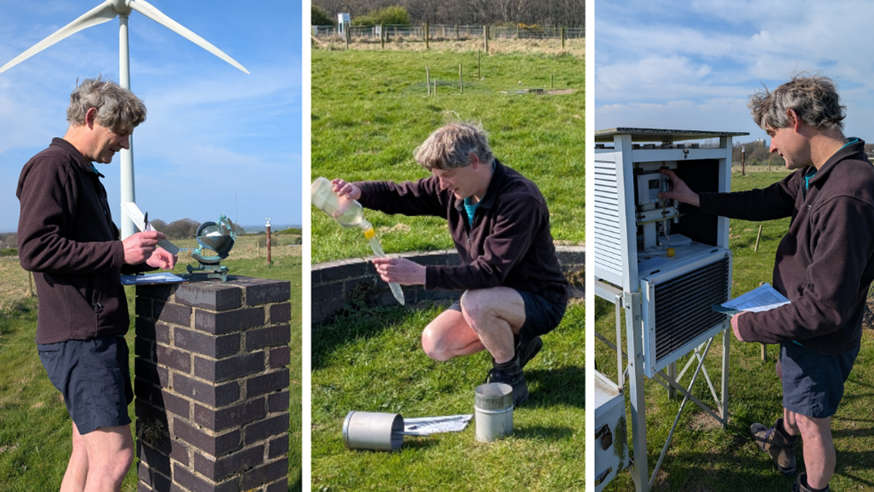
Scientists at Lancaster University’s Hazelrigg weather station have recorded the sunniest and warmest spring since measurements began at the site in the 1960s.
Sunshine totals had exceeded the previous record - set during the lockdown of 2020 - for the whole of Spring (which counts as March, April and May) by May 20.
By the end of spring sunshine totals were more than one and a half times the average and the site experienced 66 hours more sunshine than in 2020.
May itself was by far the sunniest May on record, with 310.9 hours, not only exceeding the previous record of 279 hours set in May 1980, but making it the sunniest of any calendar month ever recorded at Hazelrigg.
The previous sunniest month recorded at the site was June 2023, which saw 291.9 hours of sunshine.
Located on a hill above Lancaster University’s campus, Hazelrigg is a UK Met Office climatological station where scientists from Lancaster University have been taking daily measurements of temperature, rainfall and sunshine etc since 1976, with a further ten-years of data collected before that on the University’s Bailrigg campus.
Scientists at the site say the sunny conditions were partly responsible for the record-breaking temperatures, with daily maximum temperatures for the season nearly 1.5C above the previous record warmest Spring.
Dr James Heath, from Lancaster Environment Centre, said: “The settled, clear conditions led to some fairly chilly nights - there were nine nights with a grass frost during May - but the overall mean average Spring temperatures were still well above the previous record, set only last year.
“The other factor here is the general warming trend – of the ten warmest Springs recorded at Hazelrigg, five have been in the 2020s, and the Met Office recently published data showing that Spring is the fastest warming of the four seasons in the UK.”


It was also the third driest spring recorded at the site. Rainfall totals ending up at just over half of average with the Spring being the driest since 1990. March had only 33% of its average rainfall making it the driest March on record; April had just 23% of its average rainfall.
Dr Heath added: “The site experienced 31 consecutive days with no measurable rainfall at all between the Easter and late May bank holidays, the end of May saw the monthly average rain falling in just one week. There was more over that bank holiday weekend than the whole of the rest of the Spring up to that point.”
Dr Heath says the reason behind all of this is that up until the last week of May, with brief interruptions in late March and over Easter, Spring 2025 has been dominated by the presence of large, ‘blocking’ high pressure systems sitting near to or over the UK.
These systems divert the usual westerly flow (the jet stream high in the atmosphere and the associated Atlantic, rain-bearing low pressure systems that normally give us rain) North and/or South of the UK.
He said: “High pressure is essentially an area with air converging in the upper troposphere, which is the part of the atmosphere where all our weather ‘happens’. There is more weight of air above us, and the only place it can go is down - warming, drying, and suppressing cloud formation in the process.
“It’s not at all unusual to have such a spell of weather in Spring, but its persistence recently has been remarkable.’’


 Praise for Lancaster and Morecambe youngsters who took part in 'tongue movement' project
Praise for Lancaster and Morecambe youngsters who took part in 'tongue movement' project
 Clinic where students offer free legal advice to reopen at Lancaster University
Clinic where students offer free legal advice to reopen at Lancaster University
 Lines reopen after train derailment on Scotland-London line
Lines reopen after train derailment on Scotland-London line
 Police arrest two and seize illegal bike in Morecambe
Police arrest two and seize illegal bike in Morecambe
 ITV commissions sixth series of Morecambe crime drama The Bay
ITV commissions sixth series of Morecambe crime drama The Bay
 E-bike shop moves from Lancaster to new Carnforth showroom
E-bike shop moves from Lancaster to new Carnforth showroom
 Lancaster workshop to tackle the issue of drink and needle spiking
Lancaster workshop to tackle the issue of drink and needle spiking
 Morecambe raw feeds shop up for three 'Animal Star' awards
Morecambe raw feeds shop up for three 'Animal Star' awards
 Two new festivals proposed for Morecambe entertainment venue the Platform
Two new festivals proposed for Morecambe entertainment venue the Platform
 Second day of disruption as work continues after train derails in Cumbria
Second day of disruption as work continues after train derails in Cumbria
 Morecambe lifeboat crew’s swift response rescues swimmer ‘being swept dangerously out to sea’
Morecambe lifeboat crew’s swift response rescues swimmer ‘being swept dangerously out to sea’
 'Street Meets' announced to answer your questions amid new wheelie bin roll-out
'Street Meets' announced to answer your questions amid new wheelie bin roll-out
 Campaign group welcomes new "life changing" bus service to Morecambe
Campaign group welcomes new "life changing" bus service to Morecambe
 Lancaster prison worker jailed for drug offences
Lancaster prison worker jailed for drug offences
 Major disruption as train derails on West Coast Main Line
Major disruption as train derails on West Coast Main Line
 Talks begin for events to mark Eric Morecambe's 100th birthday
Talks begin for events to mark Eric Morecambe's 100th birthday
 Lancaster music venue due to shut will now stay open "well into 2026"
Lancaster music venue due to shut will now stay open "well into 2026"
 Halloween What's On Guide
Halloween What's On Guide
 LISTEN: Launch of new group in Morecambe to help with gambling addiction
LISTEN: Launch of new group in Morecambe to help with gambling addiction
 LISTEN: New centre for people with disabilities to open in historic Lancaster location
LISTEN: New centre for people with disabilities to open in historic Lancaster location






